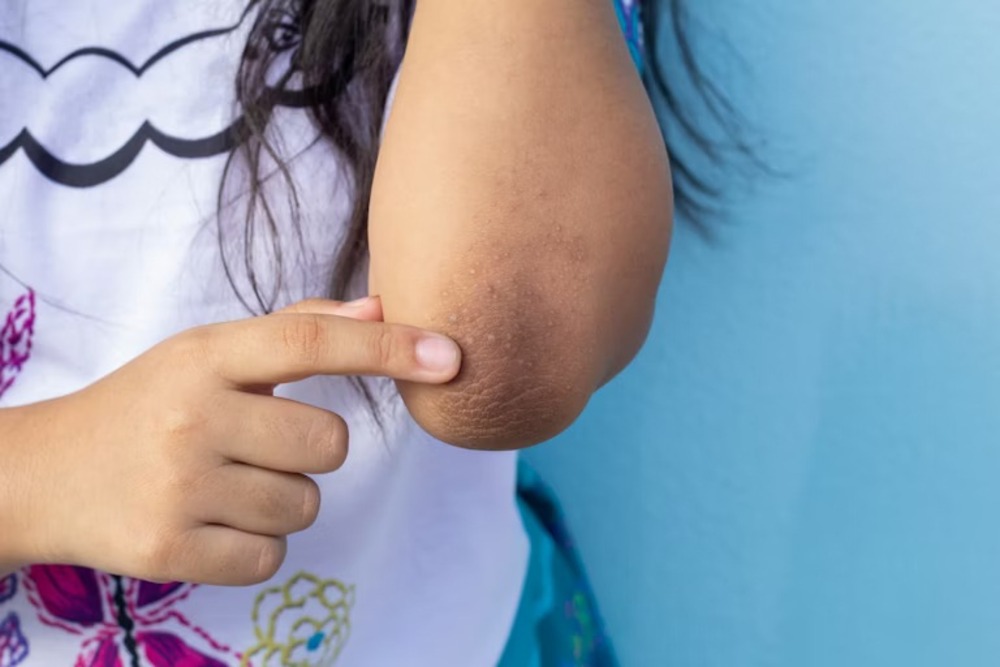
Acanthosis nigricans is a skin condition that causes dark, thick, velvety patches in body folds and creases. It typically affects the armpits, groin, and back of the neck.
This condition develops slowly over time. In rare cases, it can be a sign of cancer in an internal organ, such as the stomach or liver. Treating the underlying cause may help restore the skin’s usual color and texture.
Why does this disease occur?
Acanthosis nigricans may develop due to several factors:
- Insulin resistance – Most individuals with this condition also have insulin resistance, a hormonal issue linked to type 2 diabetes.
- Medications and supplements – Certain drugs, including high-dose niacin, birth control pills, prednisone, and other corticosteroids, can trigger the condition.
- Cancer – In rare cases, cancers such as lymphoma or tumors of the stomach, colon, or liver may lead to acanthosis nigricans.
Who is at risk of this disease?
You may be at higher risk if you:
- Have obesity
- Have a family history of acanthosis nigricans
- Belong to families where obesity and type 2 diabetes are common
People with acanthosis nigricans are also much more likely to develop type 2 diabetes.
What are the symptoms?
- Dark, thick, velvety skin in body folds and creases
- Most commonly appears in the armpits, groin, and back of the neck
- Itching
- Odor in affected areas
- Skin tags
The condition develops slowly and may not cause noticeable problems at first.
How is this disease diagnosed?
Acanthosis nigricans is usually found during a skin exam. To confirm the diagnosis, your healthcare provider may:
- Take a skin sample (biopsy)
- Order tests to determine the underlying cause of your symptoms
What is the treatment?
There is no direct cure for acanthosis nigricans. Management usually focuses on addressing the underlying cause and relieving symptoms. It includes;
Topical treatments – Skin creams, medicated soaps, or laser therapy can help reduce discomfort, odor, or thickened patches
Weight management – Losing weight may improve the condition when obesity is a contributing factor
Medication review – Stopping or adjusting drugs that trigger the condition may help
Surgery – If a cancerous tumor is responsible, its removal can improve skin changes
Treating the root cause often leads to noticeable improvement in the skin’s appearance.
When should you see a doctor?
Consult your healthcare provider if you notice:
- Sudden changes in skin color or thickness
- Rapid spreading of dark patches
- Symptoms that suggest an underlying condition needing treatment
Frequently Asked Questions (FAQs)
Q1. Can acanthosis nigricans go away on its own?
No, it does not go away on its own. The affected skin may remain unchanged, but treatment of the underlying cause is necessary for improvement.
Q2. Is it painful?
Most cases are not painful. Symptoms are mostly limited to skin changes, itching, odor, or skin tags.
Q3. Is it related to diabetes?
Yes, most people with acanthosis nigricans have insulin resistance, which is linked to type 2 diabetes.
Q4. Can children get acanthosis nigricans?
Yes, children can develop it, especially if they have obesity or a family history of diabetes.
Q5. Can it signal cancer?
In rare cases, yes. It can be associated with cancers such as lymphoma or tumors in the stomach, colon, or liver.
Important Note: This information is for awareness purposes only. Always consult a healthcare professional for advice, diagnosis, or treatment.









